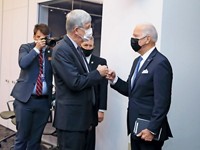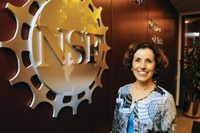Advertisement
Grab your lab coat. Let's get started
Welcome!
Welcome!
Create an account below to get 6 C&EN articles per month, receive newsletters and more - all free.
It seems this is your first time logging in online. Please enter the following information to continue.
As an ACS member you automatically get access to this site. All we need is few more details to create your reading experience.
Not you? Sign in with a different account.
Not you? Sign in with a different account.
ERROR 1
ERROR 1
ERROR 2
ERROR 2
ERROR 2
ERROR 2
ERROR 2
Password and Confirm password must match.
If you have an ACS member number, please enter it here so we can link this account to your membership. (optional)
ERROR 2
ACS values your privacy. By submitting your information, you are gaining access to C&EN and subscribing to our weekly newsletter. We use the information you provide to make your reading experience better, and we will never sell your data to third party members.
Careers
Aiding Innovation In Tough Fiscal Times
Experts warn that scientific creativity in the U.S. will decline without adequate funding
by Linda Wang
July 25, 2011
| A version of this story appeared in
Volume 89, Issue 30

The U.S. is losing its competitive edge as a result of a lack of funding for innovation by both the government and private investors, researchers said last month at a forum organized by the Brookings Institution’s Hamilton Project, which aims to address economic challenges in the U.S.
Held in Washington, D.C., the forum—Ph.D.s, Policies, and Patents: Innovation and America’s Future—brought together researchers, economists, and business leaders to examine what role U.S. policy can play in creating a positive environment to promote innovative developments. One panel focused on funding challenges facing scientists.
“There is good news and bad news,” said panelist Francis S. Collins, director of the National Institutes of Health. “The good news is that there is a lot of innovation in our universities and in our companies in terms of coming up with potential major advances that are going to be beneficial to the public and to the environment. The bad news is that capital is harder to find right now than it has been at times in the past.”
He pointed out that NIH used to fund roughly one of every three grant proposals that it received. But since 2003, budgets have been flat, and he anticipates that this year the agency will fund only one of every six grant proposals that it receives. “That means that a lot of early-stage investigators who are trying to get started, who are oftentimes the engine of these bright, creative ideas, are simply having difficulty getting their laboratories going because they depend upon that grant support.”
Angela M. Belcher, a professor of materials science and engineering and of biological engineering at Massachusetts Institute of Technology, described her interdisciplinary research into how nature makes materials and pointed out that if venture capitalists had not funded the companies she founded at the early stages of her career, her breakthrough inventions would never have reached commercialization. “It really took people staying with us and believing in us,” she said.
Now, investors are much less likely to take a chance on new ideas. “Unless you’ve got something that clearly is going to result in profit in the fairly short term, it’s harder these days to find investors who are willing to put the money into it,” Collins said. “My concern is that we have young scientists who never had the chance to get into this environment, to be able to pursue such inventive ideas, just because of funding constraints.”
At NIH, he said, the agency tries to free up enough funds to be able to support as many new applications as they can, “even if it means that some of the continuing applications are being cut back. But still, that means five out of six of these new proposals, in which there are kernels of innovation that could make a difference both for health and for our economy, are going begging in the current circumstance.”
As a result, some of the most creative ideas are being overlooked, Collins warned. “Sometimes it’s the wacky science that you most don’t want to miss supporting,” he said.
Belcher noted that today can be a promising time for science as postdocs and young faculty increasingly come from interdisciplinary backgrounds. “We really need to figure out how to keep facilitating that so those young investigators make it more into the mainstream funding, so that they can have the radical ideas that change the way we treat disease or the way that we make new materials or solve problems,” she said.
It’s critical, too, that the U.S. cultivate its own scientists, Collins said. “We can’t continue to count on the fact that our scientific leadership is going to come from other countries,” he said. “We’ve had a great opportunity in the past to recruit bright minds from all over the world, and many of them have stayed and become central to our own national success. But they are increasingly not staying. The opportunities to go back to their home country in places like China and India are getting very strong, and we have not particularly been friendly to many of those individuals in terms of our visa policies. I think we’re headed for a real potential problem here just in terms of scientific talent.”
Collins emphasized that funding for research is critically important to maintaining the U.S.’s competitive edge. “I hope you get the sense of the unprecedented opportunities that lie in front of us if we can simply push forward at the maximum speed,” he said.





Join the conversation
Contact the reporter
Submit a Letter to the Editor for publication
Engage with us on Twitter